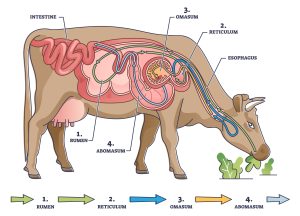 We’ve all heard the myth: “A Cow Has Four Stomachs”
We’ve all heard the myth: “A Cow Has Four Stomachs”
But has anyone really ever contemplated whether this was fact or fiction? While there are many interesting facts about cows, the answer to this equation: it’s half the truth. While our beautiful bovines only have one stomach, they has four unique compartments within.
Each of the cows four stomach compartments work together to break down and digest the course food they eat.
Why A Cow Has Four Stomachs

A cow spends about 6.5 hours eating and drinking all of its food in day. This fact alone should explain why these animals need 4 different compartments to ensure everything is properly digested
Cows are different from humans in their chewing process. While humans will an average chew something up to 30 times before swallowing, cows chew 1-4 times, just enough to gulp it down. This nearly un-chewed food travels to the first two compartments, then is stored until later.
The next two phases come into play much later when the cow begins to cough up cud. Cud is a result of undigested food particles that are belched up. These pieces are then chewed and re-swallowed, then enter the third and fourth stomachs to be fully digested.
Let us now moo’ve over and explain in more detail what each part does in the digestive tract of our spotted friends:
1.The Rumen
The largest compartment of the cow’s stomach is called The Rumen. It has a volume of 150-200 liters and can hold 40-50 liters of water. The cow’s rumen is largely a fermentation vat hat helps to store the food after it’s eaten.
Similar to that of a birds, the rumen has no digestive lining and it merely just an extension of the esophagus. Although it doesn’t necessarily digest food in itself, it contains bacteria, protozoans and some fungi that help the cow digest the food hours later
Interesting fact: This fermentation phase produces a lot of gas, which is why bovines tend to belch a lot. They’re not being rude, they just can’t help it!
2.The Reticulum
The result of the production from the first compartment results in a liquid trickling down into the second chamber, The Reticulum. This is the process where the saliva mixes with the food and cud. This process works by the cow burping (again Bessy!!) cud into their own mouths and chewing on it.
Interesting fact: If you ever see a cow that looks like they’re chomping down on a huge piece of hubba bubba bubble gum, this is the actuality of the situation.
3.The Omasum
The third part in the cow’s stomach is called The Omasum. This compartment is responsible for absorbing water and nutrients such as potassium and sodium. This section holds up to 30-60 % of the overall water intake.
The omasum also blocks larger particles from entering the digestive tract that could cause harm to the cow’s body.
Interesting fact: There are many functions of the omasum that we have even discovered yet!
4.The Abomasum
The last compartment in the cow’s stomach is called The Abomasum. Gastric fluids are produced in this stage that allow the function of digesting protein from the feed and ruminal microbes.
Interesting fact= The pH level in this stage is 2-3.
Trust Your Local Dairy Farmer For Delicious Milk From Happy Cows
Happy California cows produce better milk. When you buy from a local dairy farm, you’re supporting your local community and your local dairy farmer. Signing up for home milk delivery means getting milk in glass bottles delivered right to your door. Milk goes from the local dairy to your doorstep, in as little steps as possible. Why drink milk in glass bottles? It tastes better. It’s better for the environment. You benefit, but so do your local dairy farmers.The glass bottles help keep your milk fresh, and they preserve the taste better than plastic containers. Glass is also 100% recyclable, which means it can be used over and over again.
To find a local dairy near you, and sign up for home milk delivery, search our database.